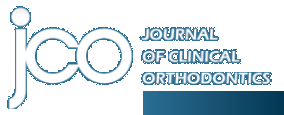Search Results For: 'orthodontics'
3281.
PEARLS
Virtually Eliminating Undercuts in Invisalign's ClinCheck
Volume 52 : Number 1 : Page 51 : Jan 2018
Posterior restorations can result in undercuts that cause the edges of Invisalign trays to fold inward, making it difficult to insert or remove aligners. This Pearl from Dr. Cetta shows how to use ClinCheck to alter the shape of the simulated gingiva around such a restoration.
3282.
Volume 10 : Number 1 : Page 9 : Jan 1976
The start of the Bicentennial Year offers us the opportunity to indulge in some patriotic sentiment. There has been so much emphasis lately on what is wrong with America, that the youth of our country...
3283.
BOOK REVIEWS
Volume 46 : Number 5 : Page 307 : May 2012
Facial Aesthetics: Concepts and Clinical Diagnosis FARHAD B. NAINI, BDS, FDS RCS, MSc, MOrtho RCS, FDS Orth RCS 456 pages. $131.99. 2011.Wiley-Blackwell, 111 River St., Hoboken, NJ 07030.(800) 225-594...
3284.
Volume 16 : Number 11 : Page 766 : Nov 1982
766-jco-img-0.jpgAn office manual, which is a compilation of practice philosophy, policies, and procedures, should be an indispensable part of any practice. A newly hired auxiliary should receive a co...
3285.
Palatal Expansion with a New Twist
Volume 28 : Number 3 : Page 0 : Mar 1994
Over the years, many modifications of the original jackscrew expansion appliance, introduced by W.H. Dwinell in 1857, have been produced. Dwinell's expansion appliance was wedged into place between th...
3286.
Treatment of Class I Malocclusion Using the Broussard Two-Force Technique
Volume 11 : Number 2 : Page 126 : Feb 1977
Many orthodontists are impressed with the ease of tooth movement which results from the application of light forces and light wire. However, they may be reluctant to abandon the classical edgewise bra...
3287.
Rapid Expansion of the Maxillary Arch, Part I
Volume 2 : Number 4 : Page 0 : Apr 1968
Rapid expansion of the maxillary arch leading to opening of the mid-palatal suture is by no means a new method of orthodontic treatment. Probably Angell (1860) first described rapid expansion of the m...
3288.
Tensile and Shear Strength of Begg Plastic Brackets
Volume 9 : Number 11 : Page 694 : Nov 1975
One of the major shortcomings in bonding technique is the questionable longevity of the brackets under orthodontic forces. Lexan, polycarboxylate, and stainless steel are the three materials currently...
3289.
Volume 10 : Number 8 : Page 589 : Aug 1976
A wheel mounted mobile storage system in which the units shuttle sideways on tracks and compact together to require only one access aisle at a time help control costs in an orthodontic office by utili...
3290.
Volume 14 : Number 11 : Page 780 : Nov 1980
The double tooth poses a variety of diagnostic, psychological, and treatment problems. Itkin and Barr2 listed the following categories of double teeth: Gemination. The partial splitting of a single bu...
3291.
CASE REPORT
Treatment of a Disc Dysfunction
Volume 16 : Number 6 : Page 408 : Jun 1982
A 26-year-old female presented with a severely restricted mandibular opening (24mm). She complained of a tight feeling in the left TMJ area, occurring toward the end of the opening range. Marked devia...
3292.
Arthroscopic Surgical TMJ Treatment: Case Report
Volume 21 : Number 4 : Page 0 : Apr 1987
A 71-year-old female presented to her general dentist for routine treatment. When the hygienist tried to take a periapical x-ray on the left side, the patient's jaw clicked and she had severe pain. Th...
3293.
Modified Maxillary Splint for Class II, Division 1 Treatment
Volume 25 : Number 4 : Page 0 : Apr 1991
Class II orthodontic therapy is ideally directed at both the correction of dentoalveolar disharmony and the attainment of an esthetic and functional dental-skeletal relationship.1,2 As a result, a wid...
3294.
Class II Bimaxillary Protrusion Treated with Magnetic Forces
Volume 26 : Number 6 : Page 0 : Jun 1992
Magnetic forces have been incorporated into orthodontic mechanics over the past decade.1-7 Although animal and clinical studies have been encouraging, some clinicians have questioned whether magnetic ...
3295.
Shear Bond Strengths of Two Ceramic Brackets
Volume 26 : Number 8 : Page 0 : Aug 1992
Several clinical complications have been associated with the use of ceramic brackets, including attrition of teeth from occlusion with the brackets, increased friction in orthodontic appliances, and r...
3296.
Rapid Maxillary Expansion in Cleft Lip and Palate Patients
Volume 28 : Number 1 : Page 0 : Jan 1994
After primary repairs of bilateral complete cleft lip and palate in children, maxillary segments are brought together by the restored lip function, thus exacerbating the maxillary constriction, partic...
3297.
Repositioning Ankylosed Maxillary Canines by Segmental Osteotomy
Volume 29 : Number 10 : Page 0 : Oct 1995
Surgical exposure followed by orthodontic traction is the usual method for bringing an impacted tooth into occlusion. Other techniques include repositioning and alignment1 and auto-transplantation.2,3...
3298.
The Lingual Plain-Wire System with Micro-Implant Anchorage
Volume 7 : Number 7 : Page 388 : Jul 2004
Despite their esthetic advantages,1 lingual orthodontic appliances have not gained widespread popularity since their introduction in the 1970s.2-10 The short interbracket distances require especially ...
3299.
Treatment of Ectopic Maxillary Canines Using a Palatal Implant for Anchorage
Volume 10 : Number 10 : Page 607 : Oct 2005
Various types of palatal implants have been proposed for use as skeletal anchorage in orthodontic treatment.1-5 In 1992, Wehrbein and colleagues, in collaboration with the Straumann Institute, introdu...
3300.
Comparison of Bond Strengths Using Different Curing Lights
Volume 40 : Number 5 : Page 0 : May 2006
Advantages of light-cured orthodontic adhesives include ease of use, longer working time--which allows more accurate bracket placement--and minimal setting time.1 The photoinitiators in these adhesive...
Showing 3281-3300 of 4092 results. Search completed in 0.12 seconds.

